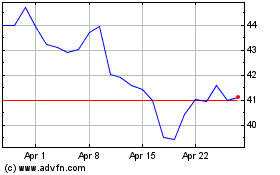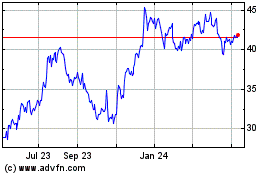Regional Lenders Lean on Fees to Fuel Revenue Growth --Update
October 16 2019 - 3:32PM
Dow Jones News
By Allison Prang
Two of the country's biggest regional lenders posted profit and
revenue for the third quarter that beat expectations, as steep
growth in mortgage banking drove fee revenue higher.
Total revenue at U.S. Bancorp, based in Minneapolis, rose by
almost 4%, but the increase was largely from higher noninterest
income, or businesses that bring in fees and aren't as sensitive to
interest rates. Fee income rose over 8% from a year earlier, while
mortgage-banking revenue alone rose by more than half.
Mortgage production volume rose about 40%, Chief Financial
Officer Terry Dolan said on the company's earnings call. Of that,
40% was from mortgage refinancing. He said long-term rates will
determine how well the mortgage business performs in the current
quarter.
"It probably will not be as strong," he told analysts. "I think
it will still be a good year-over-year story."
Net interest income, or the money the bank rakes in from lending
after it pays out interest to customers, rose less than 1%. U.S.
Bank is expecting net interest income on a fully taxable equivalent
basis to fall in the low single digits in the current quarter.
That line item for banks is negatively impacted in
lower-interest-rate environments because the lower rates are, the
less banks can charge customers for certain loans. The Federal
Reserve has already cut rates twice this year.
At PNC, noninterest income also drove revenue, which rose just
over 3%. Residential mortgage and consumer services were among the
areas that helped push noninterest income up over 5% from a year
earlier.
Residential mortgage fees rose 76% year-over-year to $134
million in the third quarter.
PNC expects fee income from the mortgage business to be between
stable to down in the fourth quarter, Chief Financial Officer
Robert Reilly said on the company's call. Net interest income rose
around 1.5%. PNC is expecting it to decline by about 1% in the
current quarter.
Chief Executive Bill Demchak commented on PNC's call Wednesday
about his expectations for net interest income in the next year,
saying it could be "a little bit worse" than he previously guided.
He later said PNC isn't dependent on the metric and pointed out the
metric's volatility.
Sometime "last week, I would have told you that it would have
been down less than 1%" he said.
Shares of PNC rose less than 0.1% early afternoon, while shares
of U.S. Bank rose 1.4%.
PNC's profit fell less than 1% from a year earlier to $1.38
billion, hurt by higher income taxes. U.S. Bank's profit was $1.91
billion, up a little more than 5%.
At PNC, The net interest margins at both PNC and U.S. Bank
declined from a year earlier and the second quarter this year.
Banks' net interest margins are an important measure of their
profitability because they measure the difference between the
interest they charge versus the interest they pay.
Average loan growth at U.S. Bank climbed 4% from a year earlier
as commercial lending increased while residential-mortgage lending
rose almost 11% year over year. PNC's average loans rose over 6%,
driven in large part by higher commercial lending.
Write to Allison Prang at allison.prang@wsj.com
(END) Dow Jones Newswires
October 16, 2019 15:17 ET (19:17 GMT)
Copyright (c) 2019 Dow Jones & Company, Inc.
US Bancorp (NYSE:USB)
Historical Stock Chart
From Mar 2024 to Apr 2024

US Bancorp (NYSE:USB)
Historical Stock Chart
From Apr 2023 to Apr 2024
